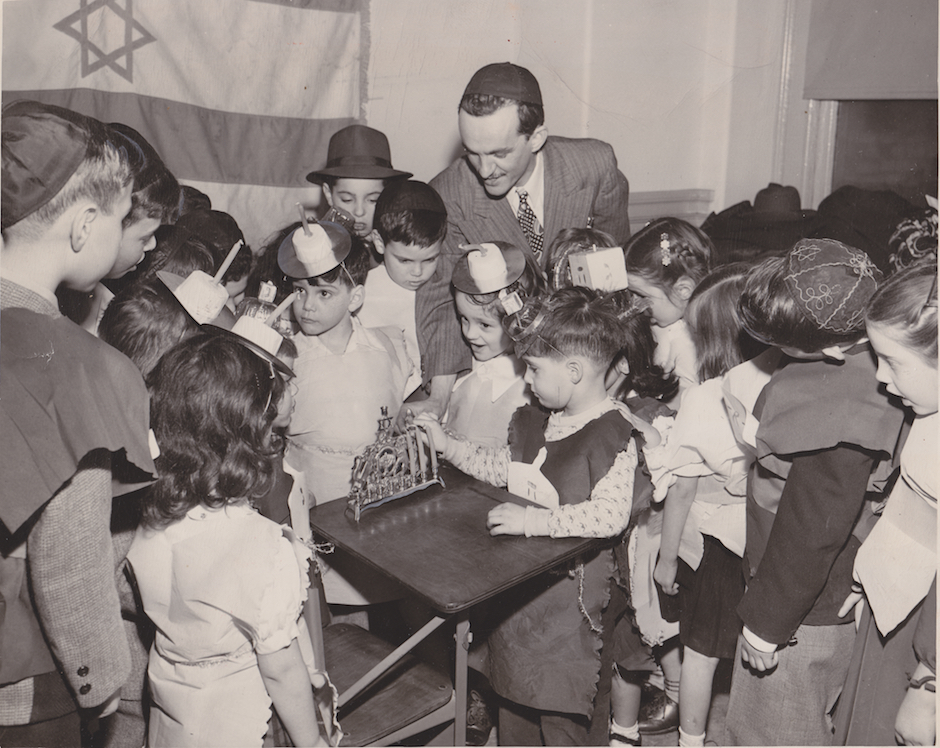
Find a lesson plan for your classroom or peruse our recommended reading lists. Have suggested content for this page? Contact us here.
LESSON PLANS
OpenBook: Discovering American Jewish History Through Objects
Download the National Museum of American Jewish History’s national curriculum OpenBook: Discovering American Jewish History Through Objects to teach American Jewish history through objects and partner learning!
In the spirit of traditional Talmudic study, OpenBook invites students to approach the study of history in unexpected ways and connect what they learn to their own ideas, experiences, and passions.
Chaplain Alexander Goode
The poster and accompanying lesson profiles U.S. Army Chaplain Alexander Goode, a rabbi who gave his life in service to his country during World War II. One of the famed "Four Chaplains," Rabbi Goode along with three Christian chaplains gave his life to save soldiers on board the transport ship Dorchester when it was torpedoed and sunk in 1943. Focus is on the role of the military during periods of crisis and the ultimate sacrifice that some individuals chose to make in service to their country.
Intended for Grades 7-12.
Israel's Independence
A downloadable poster features the spontaneous celebration on May 14, 1948 when eight-year-old Oren Zinder raised a new flag on Embassy Row-- the flag of the State of Israel.
Accompanying lesson materials including classroom worksheets focusing on the importance of teen social activism both then and now, and the role that teens played in rallying public support of the new State. Educational focus on the history of the creation of the state of Israel and its relationship with the United States.
Intended for Grades 5-12.
Jewish Life in Mr. Lincoln's City
The poster tells stories of members of the Jewish community living and serving in the nation's capital during the Civil War--for both the Union and Confederacy. A Medal of Honor winner and well as a southern spy are featured.
Intended for Grades 6-12.
Writing Home: A Letter from an early American Jew
We know little about Rebecca Samuel outside of what her letters provide for us: a slice of her life as a Jewish woman in early America. In this letter, originally written in Yiddish in the 1790s to her parents in Hamburg, Germany, Rebecca describes her life in Petersburg, Virginia. This lesson uses Rebecca's captivating letter as a centerpiece for interactive sessions about Jewish immigration and the development of the Jewish community in America.
For youth, families/congregations, and adults
Ray Frank's Yom Kippur Sermon, 1890
Ray Frank (1861-1948), called the "Girl Rabbi of the Golden West," became the first Jewish woman to preach formally from a pulpit in 1890, when she delivered sermons for the High Holy Days in Spokane, WA. Although the language of her Yom Kippur sermon may sound old fashioned, Frank's message remains both relevant and compelling.
For middle school, high school, families/congregations, adults, and adult women
"We Have Found You Wanting": Labor Activism and Communal Responsibility
A Jewish immigrant activist and a lifelong advocate for the rights of workers and of women, Rose Schneiderman shaped the American labor movement. Known as a powerful orator, Schneiderman used her speeches, such as the one she delivered in April, 1911 to protest the tragedy of the Triangle Shirtwaist Factory fire, to galvanize leaders and ordinary citizens to action on behalf of workers, immigrants, and other disadvantaged members of society. This edition of Go & Learn uses Schneiderman's speech and life example to explore our communal and individual responsibilities for the well being of others in our midst.
For youth, families, congregations, and adults
Everything Possible: JDC and the Children of the DP Camps
Following World War II, around 250,000 European Jews who had survived the Holocaust made their way to the displaced persons (DP) camps established by the Allied Armed Forces in Germany, Austria and Italy. These overcrowded and bleak environments provided the barest of necessities. Supplementing the relief supplied by the U.S. Army, the United Nations Relief and Rehabilitation Administration and its successor, the International Refugee Organization, JDC provided critical services that nourished both body and soul: food, medicine, clothing, tools, educational and religious materials. JDC placed special attention on the unique needs of the growing population of children in the camps.
Learn more in this online resource from the JDC.
George Washington's Letter to the Hebrew Congregation in Newport, Rhode Island
Though Colonial America was more tolerant of religious diversity than Europe, it had not yet become a beacon of religious liberty. The absence of liberty weighed on the minds of people like Moses Seixas, Warden of the Jeshuat Israel Synagogue in Rhode Island.
This online resource will help your students explore the history of religious liberty in America and its ongoing importance.
READING LISTS
Theme segment for pop-up New Year card, ca. 1890-1920. People reading from prayerbooks on the quay of the East River in tashlich service, performed during the holiday of Rosh Hashanah. Hebrew Publishing Co. National Museum of American Jewish History, 1982.20.2.
"Four Books to Read for Jewish American Heritage Month," National Museum of American Jewish History:
nmajh.org/NMAJHBlog.aspx?id=3739&blogid=101
"There’s a Book for That: Jewish American Heritage Month," Penguin Random House:
global.penguinrandomhouse.com/announcements/theres-a-book-for-that-jewish-american-heritage-month/
"Reading Lists," Jewish Book Council:
jewishbookcouncil.org/books/reading-lists
"Contemporary Jewish Books in honor of Jewish American Heritage Month," Maltz Museum:
maltzmuseum.org/a-book-list-of-contemporary-jewish-books-in-honor-of-jewish-american-heritage-month/
"Books Matter: Children's Literature," Anti-Defamation League:
adl.org/education-and-resources/resources-for-educators-parents-families/childrens-literature
"Our List," Fig Tree Books:
figtreebooks.net/book-types/our-list/
"Your Jewish Heritage Month Reading List," Read It Forward:
readitforward.com/bookshelf/your-jewish-heritage-month-reading-list/
"Jewish American Heritage Month & PJ Library Books," PJ Library:
pjlibrary.org/beyond-books/pjblog/may-2014/jewish-american-heritage-month-pj-library-books
"What to Read During Jewish American Heritage Month," Book Riot:
bookriot.com/2015/05/07/read-jewish-american-heritage-month/
Top Banner Image: Rabbi Chaim Lipschitz teaches first- and second-graders at the Beth Jacob School at Third and Catharine the Hebrew blessing over the lights in 1948. National Museum of American Jewish History. 1991.17.63.










